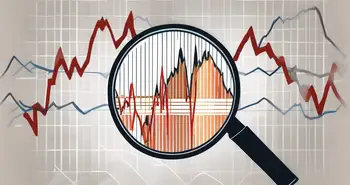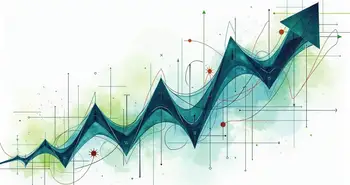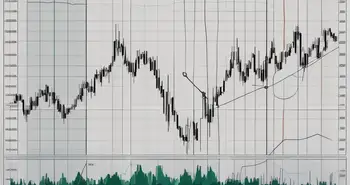Understanding the Elliott Wave Theory: A Comprehensive Guide

As an expert in the field of market analysis and trading strategies, I am excited to present to you this comprehensive guide on the Elliott Wave Theory. Developed by Ralph Nelson Elliott in the 1930s, this theory has revolutionized the way traders and investors analyze financial markets. Join me as we delve into the intricacies of the Elliott Wave Theory and uncover its endless possibilities.
Introduction to the Elliott Wave Theory
The Elliott Wave Theory, also known as Elliott Wave Principle, is a technical analysis tool that aims to identify predictable patterns in financial markets. By understanding these patterns, traders can gain insights into future price movements, enabling them to make informed investment decisions.
The Elliott Wave Theory is a comprehensive framework that provides a unique perspective on market behavior. It combines elements of mathematics, psychology, and social science to analyze market trends and forecast potential price movements. This theory has been widely studied and applied by traders and investors around the world.
Origin and Development of the Elliott Wave Theory
Created by Ralph Nelson Elliott, the Elliott Wave Theory is based on the concept that market movements follow repetitive wave patterns. Elliott, an accountant by profession, spent years studying price charts and analyzing market data. Through his meticulous observations, he discovered that market trends consist of a series of upward and downward swings, which he called waves.
Elliott's groundbreaking work on wave patterns laid the foundation for his theory. He believed that these waves are not random fluctuations but rather a reflection of the collective psychology of market participants. In 1938, Elliott published his seminal book, “The Wave Principle,” which introduced his theory to the world.
Since its publication, the Elliott Wave Theory has garnered significant attention and recognition from traders and analysts. Its ability to provide a structured framework for understanding market behavior has made it a valuable tool in the field of technical analysis.
Basic Principles of the Elliott Wave Theory
The Elliott Wave Theory is built upon a few key principles that form the basis of its analysis. Firstly, markets move in a rhythmic pattern of five waves in the direction of the primary trend, followed by three waves in the opposite direction. These waves are labeled as impulse waves and corrective waves, respectively.
Furthermore, Elliott observed that these waves can be further divided into smaller degree waves, creating a fractal-like structure. This means that each wave can be analyzed on multiple timeframes, from the long-term to the short-term, revealing the intricate details of market movements.
Another fundamental aspect of the Elliott Wave Theory is the influence of human psychology and social behaviors on market trends. Elliott believed that market participants' emotions, such as fear and greed, drive the formation of these waves. As a result, the theory seeks to understand the underlying psychological factors that contribute to price movements.
By applying the Elliott Wave Theory, traders can gain a deeper understanding of market dynamics and anticipate potential turning points. This can help them identify favorable entry and exit points for their trades, enhancing their chances of success in the financial markets.
The Five-Wave Pattern
The foundation of the Elliott Wave Theory lies in the sophisticated understanding of the five-wave pattern. These five waves are labeled with numbers and letters: 1, 2, 3, 4, and 5 for the upward trend, and A, B, and C for the downward trend.
Understanding Impulse Waves
The impulse waves, labeled as 1, 2, 3, 4, and 5, represent the primary trend in the direction of the market. Impulse waves are characterized by strong price movements and show the dominant force of the market at that time.
When analyzing impulse waves, it is important to note that wave 3 is typically the strongest and longest wave. It often exhibits the most significant price movement and is considered the backbone of the trend. Wave 1, on the other hand, is usually the shortest and weakest of the impulse waves. It serves as the starting point of the trend, often characterized by a cautious market sentiment.
Wave 2 is a corrective wave that follows wave 1. It is a temporary pullback in the market, where prices retrace a portion of the gains made in wave 1. Wave 2 is often seen as an opportunity for traders to enter the market at a more favorable price before the trend resumes.
After wave 2, the market enters wave 3, which is the most powerful and dynamic wave. It is often the longest and strongest wave in terms of price movement. Wave 3 is fueled by increasing market participation and a growing consensus among traders, leading to significant price advances.
Following wave 3, wave 4 is a corrective wave that retraces a portion of the gains made in wave 3. It is a temporary pause in the trend, often characterized by a consolidation or sideways movement. Wave 4 provides an opportunity for traders to take profits or adjust their positions before the final wave of the impulse pattern.
Finally, wave 5 completes the impulse wave pattern. It is the last wave of the primary trend and is often accompanied by a surge in trading volume. Wave 5 represents the final push of the dominant force in the market before a reversal or a significant correction occurs.
Decoding Corrective Waves
After the completion of the five-wave pattern, the market enters a corrective phase. Corrective waves are labeled as A, B, and C and move in the opposite direction of the dominant trend. Corrective waves aim to consolidate the previous impulse waves and prepare for the next move in the primary trend.
Wave A is the first corrective wave and is often seen as a counter-trend move. It retraces a portion of the gains made in the previous impulse wave, but it does not necessarily erase all the progress. Wave A is usually followed by wave B, which is a temporary recovery or a pullback in the opposite direction of wave A. Wave B aims to lure in traders who believe that the previous trend is resuming, only to be followed by another leg down.
Finally, wave C completes the corrective wave pattern. It is the most powerful and dynamic wave among the corrective waves. Wave C often extends beyond the starting point of wave A and aims to trap traders who are still holding onto the previous trend. Wave C marks the end of the corrective phase and sets the stage for the next impulse wave to begin.
It is important to note that corrective waves can take various forms, such as zigzags, flats, triangles, or combinations. Each corrective wave pattern has its own unique characteristics and provides valuable insights into the market's psychology and sentiment.
By understanding and analyzing the five-wave pattern and the subsequent corrective waves, traders can gain a deeper understanding of market trends and potentially identify profitable trading opportunities. The Elliott Wave Theory provides a framework for interpreting market behavior and can be a valuable tool in a trader's arsenal.
The Three-Wave Pattern
In addition to the five-wave pattern, the Elliott Wave Theory recognizes the existence of the three-wave pattern. This pattern acts as a corrective movement within the overall trend.
The Role of Zigzag Corrections
Zigzag corrections are the most common type of three-wave pattern. These corrections consist of three waves: A, B, and C. The A and C waves move in the same direction as the primary trend, while the B wave moves in the opposite direction. Zigzag corrections offer traders opportunities to enter or exit positions at favorable points.
The Significance of Flat Corrections
Flat corrections, another type of three-wave pattern, are characterized by a sideways movement. In flat corrections, the A wave usually retraces quite deeply, the B wave is a short and swift reversal, and the C wave retests the previous high or low. Understanding flat corrections enables traders to identify potential reversal points.
Fibonacci Numbers and the Elliott Wave Theory
The Elliott Wave Theory incorporates the use of Fibonacci numbers, a sequence of numbers that have a unique mathematical relationship. These numbers, particularly the Golden Ratio, hold significance in forecasting market movements.
The Golden Ratio and Its Importance
The Golden Ratio, approximately 1.618, is a key element in the Elliott Wave Theory. It is believed to be present in many natural phenomena and is also reflected in financial markets. Traders often rely on Fibonacci retracement levels, derived from the Golden Ratio, to identify potential support and resistance levels.
Fibonacci Sequence in Wave Predictions
Applying the Fibonacci sequence to wave predictions allows traders to estimate the potential length and duration of different waves. By combining the Elliott Wave Theory with Fibonacci analysis, traders can enhance their understanding of market dynamics and improve their trading decisions.
Practical Applications of the Elliott Wave Theory
Now that we have covered the fundamentals, let's explore how the Elliott Wave Theory can be applied in real-life trading scenarios.
Using Elliott Wave Theory in Trading
Traders can use the Elliott Wave Theory to identify potential entry and exit points in the market. By understanding the wave patterns, traders can anticipate trend reversals, confirm the direction of the current trend, and manage risk effectively. It is important to note that combining the theory with other technical analysis tools can further enhance trading strategies.
Limitations and Criticisms of the Elliott Wave Theory
Like any technical analysis tool, the Elliott Wave Theory has its limitations. Critics argue that the theory is highly subjective and open to interpretation. It requires a deep understanding of market behavior and human psychology. Additionally, it can be challenging to accurately identify and label waves. Traders should use the Elliott Wave Theory as a complementary tool rather than relying solely on it.
As an expert in the field, I can confidently say that the Elliott Wave Theory has the potential to provide valuable insights into market trends. However, it requires dedication, practice, and constant learning to master this analysis tool. By combining the Elliott Wave Theory with other technical analysis approaches, traders can develop a robust trading strategy that takes advantage of market opportunities.
If you're new to the Elliott Wave Theory, don't get discouraged by its complexity. Keep learning, practicing, and refining your skills. Understanding market behavior through the lens of Elliott waves can be a game-changer for your trading journey.
FAQs
What is the Elliott Wave Theory?
The Elliott Wave Theory is a technical analysis tool developed by Ralph Nelson Elliott in the 1930s. It aims to identify predictable wave patterns in financial markets, allowing traders to make informed investment decisions.
What are the basic principles of the Elliott Wave Theory?
The Elliott Wave Theory is based on the principles that markets move in a rhythmic pattern of five waves in the direction of the primary trend, followed by three waves in the opposite direction. These waves can be further divided into smaller degree waves, and they are influenced by human psychology and social behaviors.
How can the Elliott Wave Theory be applied in trading?
Traders can use the Elliott Wave Theory to identify potential entry and exit points in the market. By understanding the wave patterns, traders can anticipate trend reversals, confirm the direction of the current trend, and manage risk effectively.
What are the limitations of the Elliott Wave Theory?
The Elliott Wave Theory has limitations and criticisms. It is subjective and open to interpretation, requires a deep understanding of market behavior, and can be challenging to accurately identify and label waves. Traders should use it as a complementary tool alongside other technical analysis approaches.
I hope this comprehensive guide has provided you with a solid foundation in understanding the Elliott Wave Theory. Remember, mastering this theory requires practice and experience. Keep exploring and honing your skills as a trader, and you'll uncover the countless possibilities this approach has to offer.
Ready to put the Elliott Wave Theory into practice and experience a new era of trading? Look no further than Morpher, the revolutionary platform that's changing the game with zero fees, infinite liquidity, and a unique blockchain-based trading experience. Whether you're interested in stocks, cryptocurrencies, or even niche markets, Morpher empowers you with fractional investing, short selling, and up to 10x leverage to maximize your strategies. Embrace the future of investing with the safety and control of the Morpher Wallet. Sign Up and Get Your Free Sign Up Bonus today, and start trading the waves like never before.

Disclaimer: All investments involve risk, and the past performance of a security, industry, sector, market, financial product, trading strategy, or individual’s trading does not guarantee future results or returns. Investors are fully responsible for any investment decisions they make. Such decisions should be based solely on an evaluation of their financial circumstances, investment objectives, risk tolerance, and liquidity needs. This post does not constitute investment advice.

Painless trading for everyone
Hundreds of markets all in one place - Apple, Bitcoin, Gold, Watches, NFTs, Sneakers and so much more.

Painless trading for everyone
Hundreds of markets all in one place - Apple, Bitcoin, Gold, Watches, NFTs, Sneakers and so much more.









